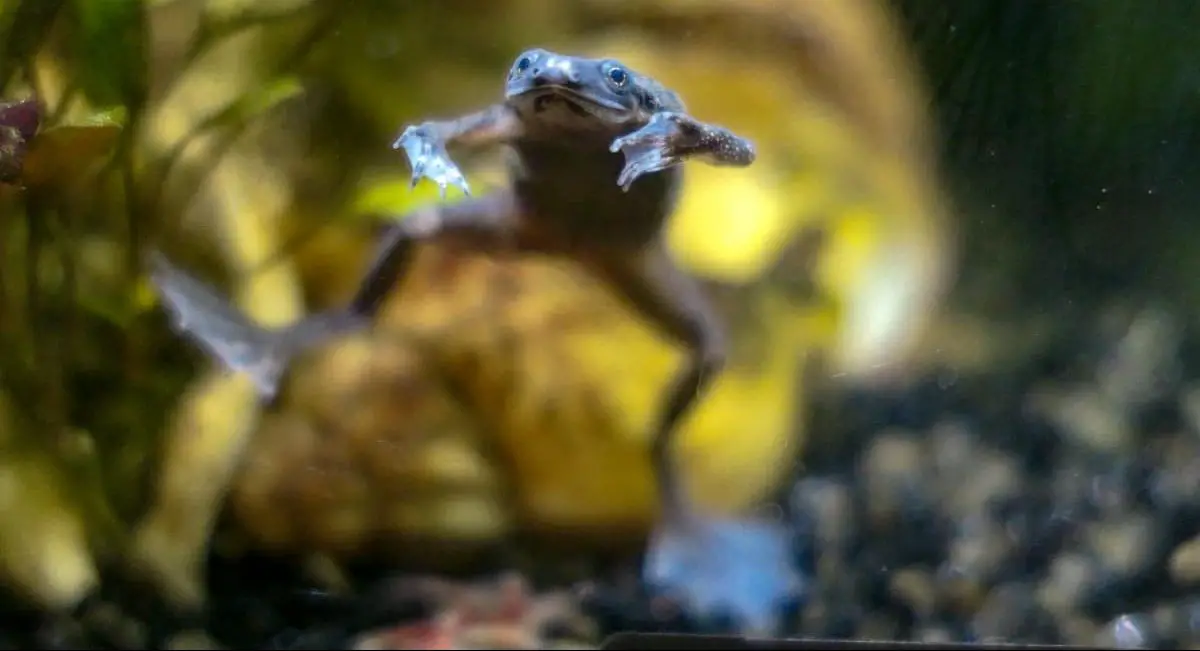Affiliate Disclosure: This post may contain affiliate links. If you make a purchase after clicking on these links I will be compensated at no extra cost to you. However, I never recommend anything I don’t love or wouldn’t use myself!
I’ve kept African Dwarf Frogs with other fish in the past and I had heard that they may be suitable tank mates for a male betta. As I am currently setting up a new tank, I decided to look into it a bit further and here’s what I found.
Can a male betta fish live with African dwarf frogs? Male betta fish and African dwarf frogs can live together, provided their tank is large enough. However, it’s important to monitor their relationship closely early on, as some male bettas can be particularly aggressive.
Although many people are aware of male bettas having aggressive tendencies (hence being known as Siamese fighting fish), there are also some lesser-known considerations when mixing bettas and African dwarf frogs.
Precautions For Keeping A Male Betta With African Dwarf Frogs
It’s widely known that male bettas can be quite territorial, which is why it’s not recommended to keep more than one in the same tank.
The good thing is that bettas can often live with other species without issue. However, problems can arise due to varying temperaments from one betta to another.
On occasion, male betta fish can be incredibly hostile and may not stand for any company whatsoever. Things will sadly not work out if this is the case for your betta.
For this reason, when introducing a male betta to new tank mates such as African dwarf frogs, it’s important to monitor behavior closely. You should also have a contingency plan should things get out of hand.
If you are thinking about setting up a new community tank, it may help if you add the betta to an already established tank. This will help curb the bettas territorial nature.
Having a tank with plenty of space for every occupant will also help mitigate any conflict.
However, what isn’t so widely known, is that African dwarf frogs can be quite aggressive towards other fish too, particularly if they do not get all of the food they need.
Dwarf frogs are also much faster swimmers than bettas, so there may be no escape for the betta should things turn sour!
One of the biggest concerns when keeping African dwarf frogs with other fish is that they can be very slow to find their food.
Bettas and other fish will often snap up the frogs’ share before they get a chance.
African dwarf frogs have very poor eyesight, so they rely on their sense of smell and touch to find their food, making mealtimes a slow process.
With correct feeding techniques which I will outline later in this article, you can ensure that your African dwarf frogs get all of the food they need.
Although this may take a little more time, it can prevent conflict and stop your frogs from becoming malnourished.
Still, it’s not all doom and gloom.
In the wild, African dwarf frogs and Bettas come from similar habitats with slow-moving, shallow waters and tropical temperatures.
African dwarf frogs usually occupy the tank floor, while bettas spend most of their time in the mid to upper regions of the tank, so they will stay out of each other’s way most of the time. They also have fairly similar diets and they can often share the same types of foods.
All in all, given the right disposition, betta fish and African dwarf frogs can make great tank mates.
African dwarf frogs should not be confused with African clawed frogs. African clawed frogs are voracious predators and will happily eat a betta fish!
Tank Size For A Male Betta Fish And African Dwarf Frogs
As with keeping most fish, the larger the tank the better. Besides giving them more space to explore, in a larger tank, it will also take much longer for toxins to build up to a dangerous level.
The recommended tank size for a betta fish is 5 US gallons (18.9 Litres) or more. Many people say bettas can get away with much smaller tanks, but you will really struggle to maintain water conditions in anything smaller and quality of life will be very poor for the betta.
It’s recommended that you allow a minimum of 1 US gallon (3.8 Litres) per African dwarf frog, although 3 US gallons (11.4 Litres) per frog is best.
As African dwarf frogs are social animals, they are best kept in groups of 2 or more. For a tank set up with 1 male betta and 2 dwarf frogs, you should allow a minimum of 10 US gallons (37.9 Litres) and an additional 3 gallons per frog thereafter.
The tank should also be no deeper than 24 inches (60.1 cm) If your tank is too deep, your African dwarf frogs will get tired when swimming to the surface for air and may become exhausted.
If you can stick to these parameters, it should be fairly easy to maintain water quality with a suitable filter. Also, your betta should have enough space to feel like his territory is not being overrun. Adding lots of plants and creating places to hide will help with this too.
Smaller tanks require more maintenance to keep them clean. More maintenance means more stress, not only for your fish but for you too.
It’s a good idea to have a lid on your tank and to block off any holes which a frog could fit through. Although African dwarf frogs breathe air, it’s very important that they stay moist. If they escape the tank (which they often do) they will dry up very quickly and die.
If you are not able to secure your lid, keep the water level around 2-3 inches from the rim of the tank to reduce the risk of your frogs (and betta) escaping.
Habitat Requirements For Bettas And African Dwarf frogs
Here are 5 things to consider when creating the perfect habitat for male betta and African dwarf frogs:
- Filter
- Tank Heater
- Substrate
- Ornaments & Plants
- Lighting
1. Having a filter will remove toxins and debris from the water so you don’t have to clean the tank as often. Filters which agitate the water’s surface will also oxygenate the water. Both bettas and African dwarf frogs struggle in stronger currents so ensure you get a filter with a gentle flow.
2. You should have a thermostatic tank heater for your betta/ADF tank and maintain a temperature of 78-80° F (25.6-26.7º C). You should also have an independent thermometer to monitor the water temperature. Integrated thermometers often give skewed readings.
3. A substrate is optional, but it’s recommended as it helps with the stability of your water quality. It acts as a great medium for harboring beneficial bacteria which will break down waste. Your best off using gravel as ADFs can get trapped or stuck in larger substrates and drown. Alternatively, smaller substrates may be accidentally consumed.
4. It’s a good idea to have plenty of plants and ornaments which will provide places to hide. Live plants can help oxygenate the water, but if you chose to go with fake plants, try to avoid plastic ones with hard edges as they often damage betta fins. The same goes when selecting ornaments, you should avoid any with rough or jagged features.
5. Lighting is optional, but both bettas and African dwarf frogs will need a day/night cycle or they may become disoriented and stressed, which can lead to more serious conditions. If you do not have good natural light, you can get some artificial lighting. Ensure there is no direct sunlight on your tank as this can lead to fluctuation in temperature and algae bloom.
Feeding ADFs In A Betta Tank
As previously mentioned, food is usually one of the biggest concerns when keeping African dwarf frogs with other fish, as they will often be the last to find it.
African dwarf frogs eat brine shrimp, bloodworms, tubifex worms, and smaller sized sinking pellets. All of which can be thoroughly enjoyable for a betta fish too.
The best way to ensure your frogs get all of the food that they need is to feed them manually. Some people use aquarium tongs or a pipette, others just by hand.
When using utensils or your hands to feed African dwarf frogs, you will need some patience initially. However, your frogs will soon learn to recognize your feeding technique and will become more efficient eaters over time.
As they are practically blind, it helps to gently wave or wiggle the food near their mouths. Besides smelling the food, it helps if they can sense movement in the water so they can pinpoint its whereabouts.
Some people use a tank divider to separate their frogs for feeding time. If you want to feed your frogs live foods this will give them time to hunt it out for themselves, without you having to intervene.
Whichever method you choose, it is important to ensure your African dwarf frogs are well fed. Otherwise, you may find betta fins are on the menu!
Related Questions
Do betta fish get lonely? Unlike some other fish, bettas will not become bored or lonely in the absence of tank mates. They do not need any company, however, some tank mates such as bottom feeders and smaller sized algae eaters will help keep their tank clean and are not likely not draw a betta’s attention.
What kinds of fish can live with a male betta? Male bettas can live with groups of schooling fish, bottom dwellers, and algae eaters as long as they aren’t too big. For example corydoras, loaches, snails, shrimp, neon tetras, harlequin rasboras and small species of pleco. However, particularly aggressive bettas may not integrate with any fish.

